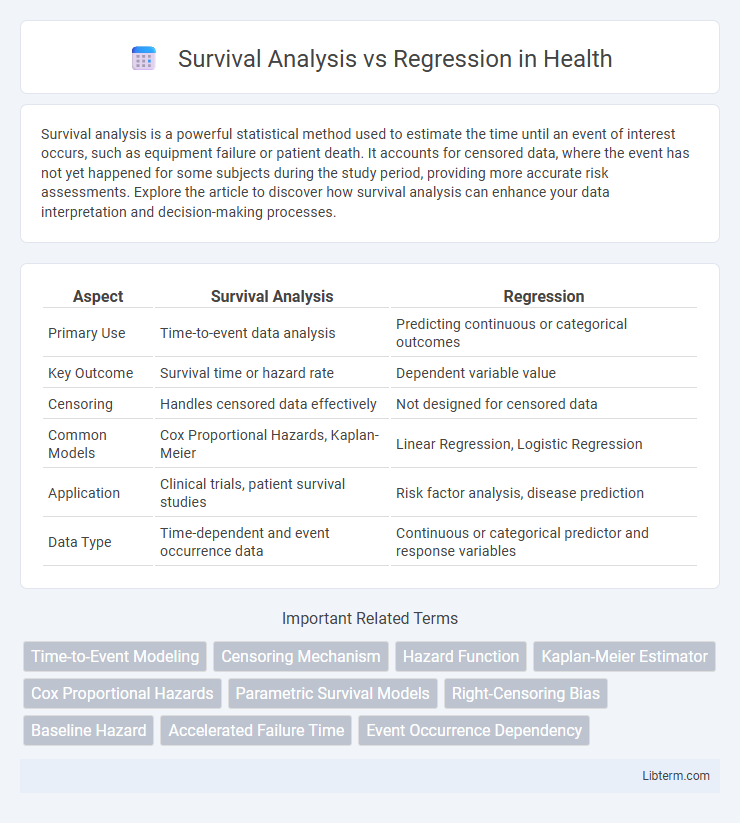Survival analysis is a powerful statistical method used to estimate the time until an event of interest occurs, such as equipment failure or patient death. It accounts for censored data, where the event has not yet happened for some subjects during the study period, providing more accurate risk assessments. Explore the article to discover how survival analysis can enhance your data interpretation and decision-making processes.
Table of Comparison
| Aspect | Survival Analysis | Regression |
|---|---|---|
| Primary Use | Time-to-event data analysis | Predicting continuous or categorical outcomes |
| Key Outcome | Survival time or hazard rate | Dependent variable value |
| Censoring | Handles censored data effectively | Not designed for censored data |
| Common Models | Cox Proportional Hazards, Kaplan-Meier | Linear Regression, Logistic Regression |
| Application | Clinical trials, patient survival studies | Risk factor analysis, disease prediction |
| Data Type | Time-dependent and event occurrence data | Continuous or categorical predictor and response variables |
Understanding Survival Analysis: An Overview
Survival analysis focuses on time-to-event data, estimating the probability of an event occurring over a specific period, unlike regression which models relationships between variables without emphasizing event timing. Key concepts in survival analysis include hazard function, survival function, and censoring, which account for incomplete observation periods. The Kaplan-Meier estimator and Cox proportional hazards model are primary methods used to analyze survival data, providing insights into the risk factors and time-dependent outcomes.
Introduction to Regression Analysis
Regression analysis estimates relationships between dependent and independent variables, providing insights into how predictors influence an outcome. Unlike survival analysis, which deals with time-to-event data and censoring, regression focuses on continuous or categorical response variables without explicit time components. Key types include linear regression for continuous outcomes and logistic regression for binary outcomes, forming foundational tools in predictive modeling and hypothesis testing.
Key Differences Between Survival Analysis and Regression
Survival analysis specifically addresses time-to-event data, handling censored observations where the event outcome is not yet observed, unlike traditional regression which assumes fully observed dependent variables. It models the survival function and hazard rates to estimate the probability of event occurrence over time, whereas regression primarily estimates relationships between independent variables and a continuous or categorical outcome. The fundamental statistical tools differ: survival analysis uses techniques like Kaplan-Meier curves and Cox proportional hazards models, while regression relies on linear or logistic regression methods.
When to Use Survival Analysis
Survival analysis is specifically designed for time-to-event data where the outcome is the duration until an event occurs, such as death, failure, or relapse, allowing for censored data where the event has not yet happened. Regression models, such as linear or logistic regression, are appropriate when predicting continuous or binary outcomes without considering the timing of events or censoring. Use survival analysis when the timing and occurrence status of an event are critical, and standard regression cannot handle incomplete follow-up information.
Applications of Regression in Data Science
Regression plays a crucial role in data science by enabling the prediction and modeling of relationships between variables, such as forecasting sales, estimating customer lifetime value, and determining risk factors in healthcare. Its applications span across multiple domains including finance for credit scoring, marketing for customer segmentation, and engineering for quality control. Unlike survival analysis which focuses on time-to-event data, regression provides continuous outcome predictions essential for trend analysis and decision-making processes.
Handling Time-to-Event Data: Survival Analysis Approach
Survival analysis specializes in handling time-to-event data by accounting for censoring and varying follow-up times, which regression models typically overlook. It estimates survival probabilities and hazard rates over time, providing insights into the timing and risk of events. Techniques like Kaplan-Meier curves and Cox proportional hazards models are fundamental for interpreting survival data accurately.
Dealing with Censored Data in Survival Analysis
Survival analysis is specifically designed to handle censored data, which occurs when the event of interest (e.g., death, failure) is not observed within the study period for some subjects. Unlike traditional regression models that require complete data, survival analysis techniques like the Kaplan-Meier estimator and Cox proportional hazards model account for right-censoring, left-censoring, and interval-censoring, providing unbiased estimates of survival probabilities and hazard rates. This makes survival analysis the preferred method for time-to-event data where censoring is inherent.
Common Statistical Models in Regression vs Survival Analysis
Common statistical models in regression include linear regression for continuous outcomes and logistic regression for binary outcomes, emphasizing prediction and estimating relationships between variables. Survival analysis models, such as Cox proportional hazards and Kaplan-Meier estimators, specifically address time-to-event data while accounting for censoring. These models prioritize understanding the timing and risk of events, which distinguishes them from traditional regression approaches focused on average outcomes.
Interpretation of Results: Survival Curves vs Regression Coefficients
Survival analysis interprets results through survival curves that display the probability of an event-free state over time, offering insight into time-to-event data patterns and differences between groups. Regression, specifically linear or logistic regression, produces coefficients that quantify the strength and direction of relationships between predictors and outcomes, facilitating precise effect estimation. Understanding survival curves emphasizes temporal risk dynamics, while regression coefficients focus on magnitude and significance of predictor variables.
Choosing the Right Method: Survival Analysis or Regression?
Choosing between survival analysis and regression depends on the nature of the outcome variable and the presence of censoring in the data. Survival analysis is optimal for time-to-event data where the event may not have occurred by the study end, handling censoring effectively. Regression methods like linear or logistic regression are suitable when the outcome is continuous or categorical without censoring, focusing on predicting the expected value or probability of the response variable.
Survival Analysis Infographic

 libterm.com
libterm.com